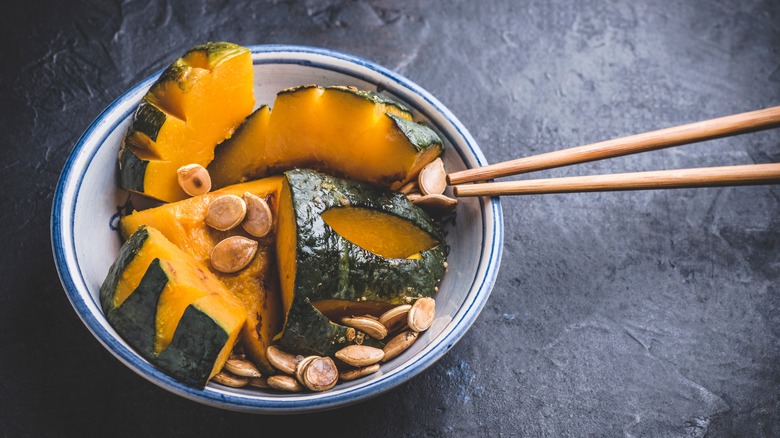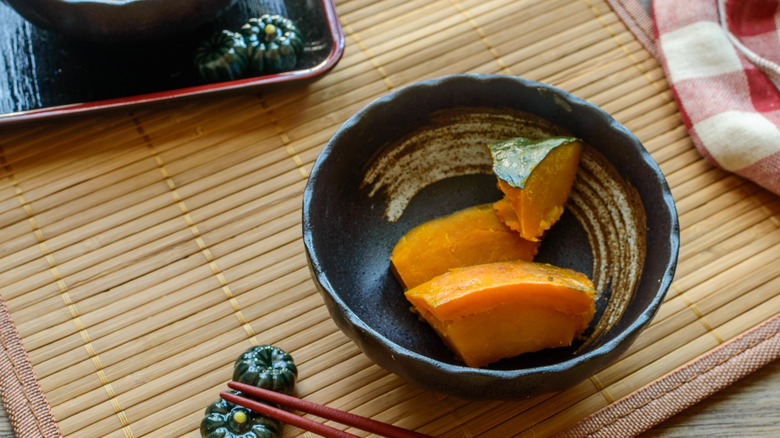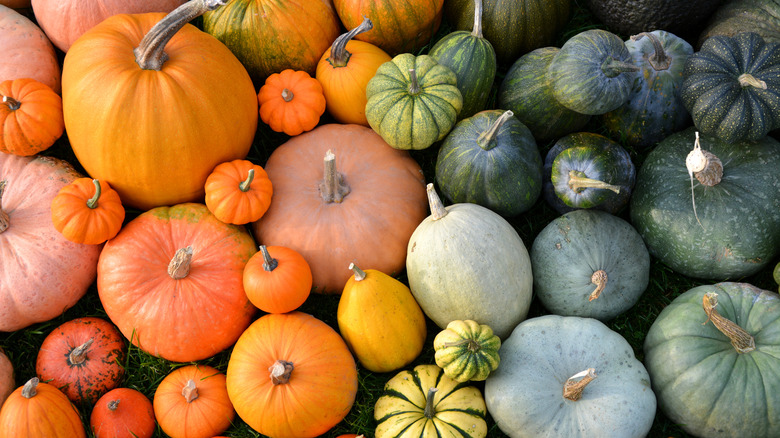What Is Kabocha Squash And How Do You Cook With It?
Imagine a type of squash that resembles a pumpkin in appearance and a sweet potato in flavor — that is kabocha squash. If you like yams, sweet potatoes, and chestnuts, kabocha may become your new favorite vegetable. Kabocha squash (Cucurbita maxima) is round and stout, with striped green skin and yellow-orange flesh. According to The Forked Spoon, it tastes much sweeter than its relative in the gourd family, butternut squash, despite its low sugar and carb content, per WebMD.
If it's hard to imagine what a kabocha squash tastes like, think fall flavors: Tender chestnuts with pumpkin. Because the kabocha belongs to the Cucurbitaceae family or gourd family, it is usually characterized as a winter vegetable that comes seasonally rather than year-round, according to "Food for Thought: The Science, Culture, & Politics of Food" by Austin Deyo and Brendan O'Malley. Despite its shared genus, kabocha's texture is more starchy than other squashes due to its lower water content (via Taste Cooking). Interestingly enough, Deyo and O'Malley note that although all members of the Cucurbita family originate from South America, kabocha in particular had less global reach.
Where did kabocha come from?
Kabocha earned its name in Japan and is known as an essential vegetable in Japanese cuisine, but it originates in South America. As with many goods, Portuguese traders brought kabocha from South America to Europe and Asia in the 16th century (via World Crops). However, unlike standard orange pumpkins (Cucurbita pepo), which were cultivated in present-day Florida and Mexico, kabocha was domesticated on the coast of Peru, according to Deyo and O'Malley's research. Pumpkins were brought to Europe right after their discovery, making them common throughout the continent, while kabocha was introduced a bit later.
According to Mihoko Oko, Portuguese explorers had trading posts in Southeast Asia, mainly Cambodia, Pegu, and Arakan. World Crops notes that the Portuguese brought the squash to their trading post in Cambodia, and from there to Japan. Thus, kabocha's name was a combination of the word "Cambodia," and the Portuguese word for pumpkin, "abóbora." Like potatoes in Ireland, kabocha squash in Japan became a staple ingredient that was used in all types of dishes, including fish soups, tempuras, and korokke or croquette.
How do you cook with kabocha?
The simplest way to prepare kabocha is to steam it in the microwave as you would a quick baked potato. You can section the kabocha and deseed, then place it into a microwave-safe bowl and cook for a few minutes. When dry-heated, the kabocha becomes sweeter as the natural sugars caramelize (via WebMD). At this point, the skin can be peeled off or you can eat it for some extra fiber and nutrients. Kabocha is sweet and tender on its own and doesn't need any butter or syrup to enhance its flavor.
In Japanese preparations, kabocha can be deep-fried or simmered. Kabocha tempura is a very popular dish, usually an essential part of any vegetable tempura plate. The kabocha is sliced into thin slivers, coated in tempura batter, and deep-fried. The result is a soft, tasty vegetable with an irresistible outer crunch. Just One Cookbook also mentions kabocha no nimono, which is kabocha simmered in dashi stock. Because kabocha is starchy and fragile, it is placed in a single layer and covered with just enough dashi to cook it. Japanese households also add fish and other vegetables to make it a hearty soup.
In Korea, kabocha is called sweet pumpkin and Korean Bapsang notes that it is most commonly used for danhobak-juk (kabocha porridge), which is a stew of macerated kabocha squash with glutinous rice and rice flour. This porridge is like a pumpkin bisque, but it is simpler in taste and thicker.
What is kabocha's nutritional value?
Our Everyday Life states that kabocha squash has a moderately high glycemic index (GI) of 75, but a lower glycemic load than sweet potato (via Very Well Fit), which means it won't drastically spike blood sugar. In fact, it only has 3 grams of sugar and 7 grams of carbohydrates per 85-gram serving, per WebMD. Although the squash is incredibly rich and caramelized in flavor, it is safe and even beneficial for diabetics, according to Dr. Axe. Furthermore, the orange flesh of a kabocha squash contains tons of lutein and beta-carotene, which can prevent cancer growth.
The fiber and potassium in a kabocha squash are also beneficial for maintaining healthy sodium levels and lowering blood pressure, per WebMD. Much like nutrient-dense avocado skin, kabocha skin gives you access to all of its added nutritional benefits. Nutrition and You also states that a kabocha squash actually contains much more vitamin C, thiamin, and pyridoxine than regular pumpkins.
Kabocha vs. pumpkin
Although kabocha and pumpkin are of the same genus, they do differ in texture, nutrients, and flavor. Taste Cooking describes kabocha as more flour-y in texture, which makes it a perfect base for baked goods. It apparently has less water content than other squashes, which is why it is more starchy. Although the two vegetables have a similar flavor profile and appearance, kabocha adds another dimension to the pumpkin with its chestnut taste.
The skin of a pumpkin (Cucurbita pepo) is usually orange in color, while the kabocha's skin is anywhere from yellow to dark green (via WebMD). Although pumpkin skins are usually discarded, Our Everyday Life states that kabocha skin is edible and even beneficial. You could eat this squash without peeling off its skin as you would delicata squash. Despite its intense sweetness, kabocha is a fantastic substitute for dishes that use common ingredients like sweet potatoes and pumpkins, according to WebMD. Thanks to its inherent roasted aroma and its starchy texture, the kabocha is a versatile squash that can be added to curry, candied yams, or pie.




